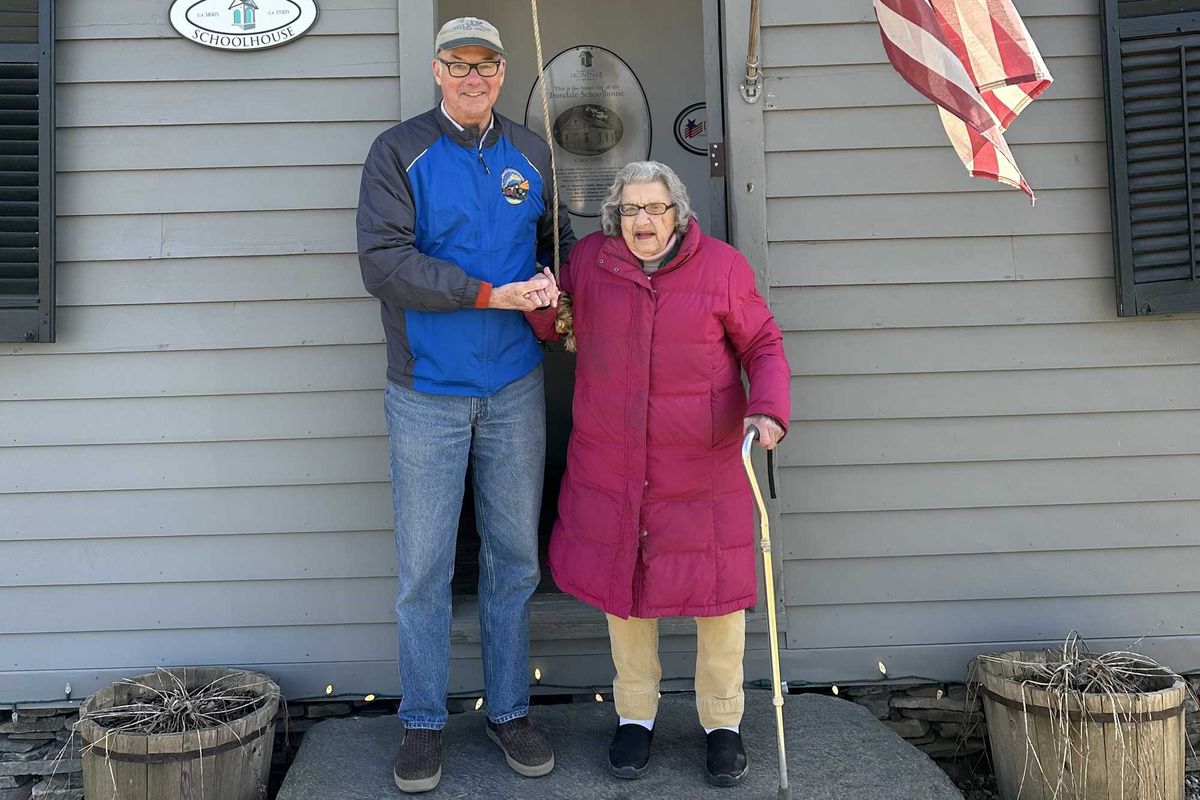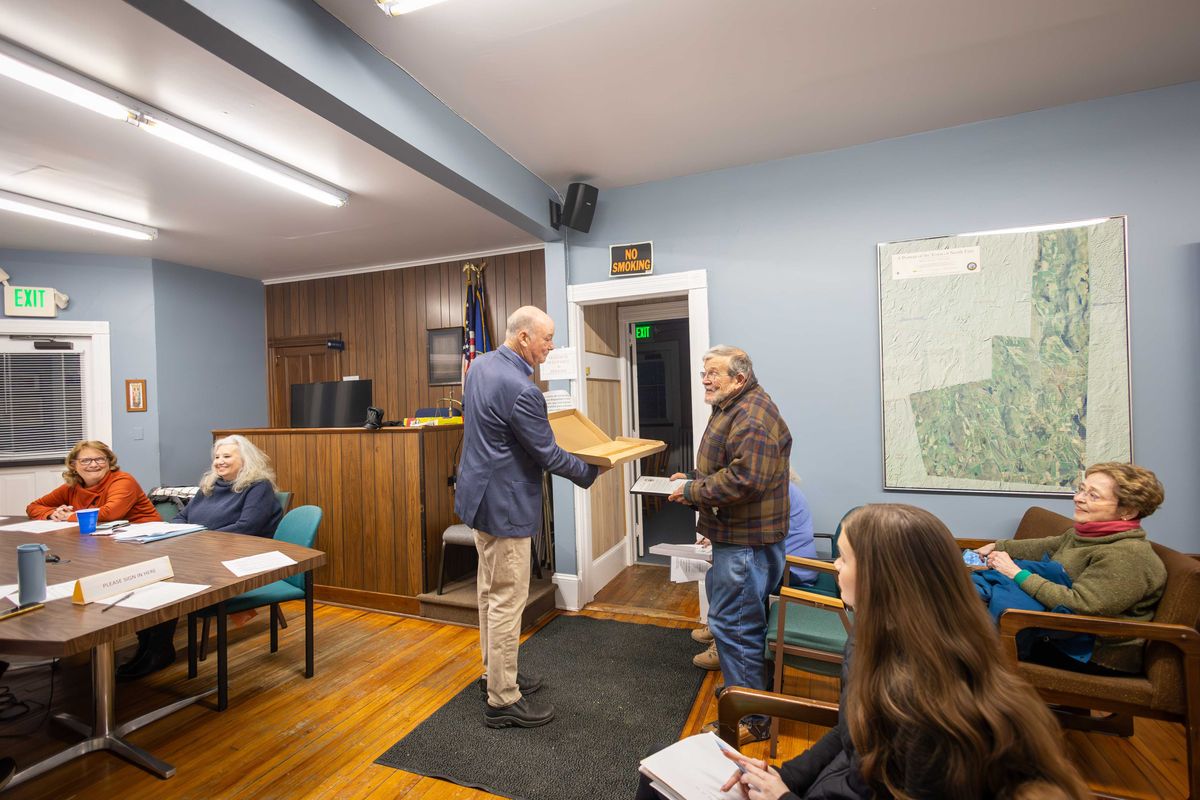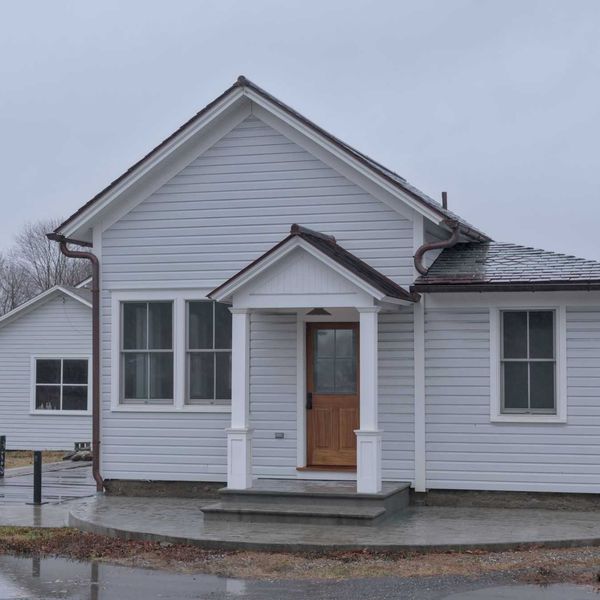Latest News
Mary Leitch, who passed away Dec. 24, is pictured at a 2024 observance marking 10 years since the Irondale Schoolhouse was relocated and restored as a visitor center for the Harlem Valley Rail Trail on Main Street in Millerton. The last living student to attend the one-room schoolhouse before it closed in 1930, Leitch was welcomed by North East Town Supervisor Chris Kennan.
Photo Provided
AMENIA — Mary Leitch, of Amenia, whose life was filled with energy, generosity, and kindness, passed away peacefully at the age of 103 on Christmas Eve morning. For decades, she touched the lives of many and left a lasting mark on the communities of Millerton, Millbrook and Amenia.
Leitch was born in Millerton in 1922 and grew up on Winchell Mountain in the hamlet of Irondale. Her early schooling was at Irondale’s 1858 one-room schoolhouse until it closed in 1930. She was proud of having been the last living person to attend that District No. 7 school, one of 14 one-room schoolhouses serving the town. From the third grade onward, she attended school in the Millerton school district.
In 2014, the Irondale schoolhouse was moved to the village of Millerton’s Main Street to serve as a visitor center for the Harlem Valley Rail Trail. The preservation project was accomplished by the Friends of the Irondale Schoolhouse, an organization that had been formed in 2008 and continues to manage the operations of the visitor center.
“If you sit still, you will rust,” was a favorite Leitch saying, perhaps inspired by the Irondale district and the area’s iron industry.
Leitch delighted in the outdoors and in the company of animals and people, caring for many dogs—especially Jack Russells—and cherishing the horses that were part of her long, vibrant life. An avid sportswoman, she enjoyed deer hunting and fishing, keeping her licenses current right up until her passing. She was a longtime member of both the Jack Russell Club of America and the Dutchess County Professional Horsemen’s Association.
In 1958, she married William (Billy) Leitch of Millbrook, a professional horseman, sharing a love of the sporting life and enjoying active membership in the Millbrook Hunt Club. Billy pre-deceased her in 2015. The pair never had any children.
Mary Leitch spent her life caring for others, whether nurturing children or tending to horses. When the pandemic began in 2020, she found yet another way to help others, sewing over 600 facemasks that she freely gave to anyone in need.
“She was mother to so many by her love,” said Bishop Gerardo Colacicco of St. Joseph’s Church in Millbrook, during her funeral mass on Tuesday, Dec. 30. Bishop Colacicco enjoyed many years of friendship and had visited with Leitch during her final days and hours, as did numerous neighbors and friends.
At the age of 101, Leitch was featured in The Millerton News by Arts Editor Natalia Zukerman, part of a series of articles highlighting her many contributions and active involvement in the community.
“She was my girl; she was everyone’s girl,” said Pine Plains resident Nan Cassidy, reflecting on decades of friendship.
“You could say a lot of nice things about Mary,” said Paula Redmond of Amenia. “No grass grew under Mary’s feet. She loved life, and she loved people,” Redmond said, a sentiment shared by Redmond’s husband, Toby Collins, from their perspective as next-door neighbors to Leitch.
“She even had a Harley Davidson at one point that she was very proud of,” Redmond added.
“Mary Leitch was a special person,” observed Pastor Douglas Grandgeorge of The Smithfield Church in Amenia. “When it was inconvenient to attend St. Joseph’s where she had been baptized after expressing a lifelong desire to be a Catholic, she gladly attended Smithfield Church with her friends and neighbors, Paula and Toby. For that reason, she and I became fast friends. She was our nearest neighbor to the north, greatly loved and respected.”
Keep ReadingShow less
North East Supervisor Chris Kennan, center left, presents outgoing Town Board member Ralph Fedele with a commemorative gift in recognition of his 12 years of service. Fedele, who retired in December 2025, received the gift during the Jan. 2 annual organizational meeting.
Photo by Aly Morrissey
MILLERTON — The North East Town Board convened for its annual organizational meeting on Friday, Jan. 2, where trustees affirmed priorities and set the tone for the year ahead.
“I’m really proud of the town hall that we have,” said Supervisor Chris Kennan. “I think we have a great group of people who work together well, and it’s a collegial place to be.”
Kennan’s three major priorities for the coming year include renovating and occupying the new Town Hall, continuing work on the town’s long-anticipated zoning revisions, and advancing plans for a wastewater and sewer system in Millerton.
Work on the new Town Hall is expected to begin in earnest this year, Kennan said. He also expressed cautious optimism about progress on a sewer system, citing a recent meeting with U.S. Rep. Pat Ryan, D-18, and noting that a previously stalled federal grant will move forward. The funding, he said, would cover a significant portion of the project’s engineering costs.
Additional grant applications are in progress, and the town and village continue to evaluate long-term options. Kennan described the completion of the project as “transformative” for Millerton, even if the impact would unfold gradually over time.
With a public hearing on the new commercial zoning draft scheduled for Thursday, Jan. 8, at 7:05 p.m. at Town Hall, Kennan acknowledged the complexity and urgency of the effort. The town’s code has not been significantly updated since 1977.
“I’m really proud of the work that the town has done to get to where we are at the moment,” Kennan said, adding that he is looking forward to the second phase of the zoning rewrite, which will look at residential zoning after the commercial district is finalized.
The board also reviewed and approved the 2026 rules of procedure for Town Board meetings, including a discussion about public comment. Although public comment is not required by law, North East welcomes it. Under the updated rules, individual speaking time will be reduced from five to three minutes, a change that Kennan says aligns with practices in surrounding towns.
During the meeting, the Board officially welcomed newly elected Councilwoman Rachele Grieco Cole and said a final farewell to outgoing board member Ralph Fedele, who retired after 12 years of service. Kennan presented Fedele with a commemorative gift in recognition of his years of service. Fedele thanked the board, noting how much the town has changed during his tenure.
“A lot has changed in 12 years, and I’m going to miss all of you,” Fedele said.
Newly re-elected Councilman Chris Mayville was appointed deputy supervisor. Mayville and Councilwoman Meg Winkler were also designated as emergency interim successors.
Much of the remainder of the meeting focused on routine appointments and reappointments. The board reappointed Daniel Sternberg to the Planning Board following the expiration of his term on Dec. 31, 2025, and reappointed Dale Culver as Planning Board Chair through Dec. 31, 2026. Bob Stevens was reappointed to continue serving as the highway superintendent.
With a vacancy on the Zoning Board of Appeals, the board reviewed an application from Henry Smedley and voted to appoint him to the board. Edie Greenwood will continue to serve as chair through Dec. 31, 2026.
The board formally designated Kenneth McLaughlin, the town’s building inspector, as zoning enforcement officer, noting that while the position is referenced in the town code, it had not been formally assigned in the past.
The board also approved standard organizational items, including regular meeting times and designated depositories, official newspapers, and engineering services, to name a few. The group also discussed ongoing training opportunities for new and returning officers offered by the New York State Association of Towns.
Keep ReadingShow less
Farmland vista where one of the proposed solar arrays for Hecate Energy's proposed Shepherd's Run solar energy array on Route 23 in Craryville, New York.
Photo by Nathan Miller
COPAKE – The past year marked another herky-jerky dance on the community solar front for this otherwise quiet hamlet.
As 2025 rolled along, the battle between Hecate Energy LLC and residents opposed to its proposed 42-megawatt Shepherd’s Run solar farm entered its eighth year.
In February, New York State officials dismissed the company’s application, and the process of review continued through the rest of the year. Officials in Albany eventually issued two additional notices of incompleteness.
Meanwhile, state legislators also weighed in on the project. State Sen. Michelle Hinchey, D-41, and State Assemblywoman Didi Barrett, D-106, both expressed concerns about the project in letters to state officials and to Gov. Kathy Hochul. Hudson Mayor Kamal Johnson wrote about concerns the city’s Common Council cited in October 2024 about the safety of Hudson’s water supply.
The project has been controversial since it initially was discussed in 2017 — planned as a 60-megawatt solar farm to be located on farmland near the intersection of Routes 23 and 7. In January 2024, the project had to be downsized after the company lost control over a portion of designated land. As it now stands, Shepherd’s Run will span 700 acres with thousands of solar panels covering 225 acres.
In other developments, last summer Hecate found itself in Delaware Chancery Court as a creditor sought a restraining order against the Chicago-based developer, owner and operator of renewable power projects. A Hecate lender claimed: “Hecate Holdings is woefully insolvent, strapped for cash, and drastically over leveraged,” a motion stated. Then, soon thereafter, a second creditor filed a similar motion in the same court claiming Hecate was in default in its loan agreements.
By the middle of the next month, in September, state officials accepted the company’s Shepherd’s Run application as “complete” and within a requisite 60-day period issued a draft permit for the project. That was in mid-November.
Next up will be public hearings. Two will be virtual airings available on Tuesday, Jan. 27, at 2 p.m. and 6 p.m. Four in-person hearings are scheduled for 2 p.m. and 6 p.m. on Wednesday, Jan. 21, 2026, and Thursday, Jan. 22, 2026, at Town Hall in Copake.
On Jan. 10, from noon to 2 p.m. at the Copake Memorial Park Building some residents have organized a community meeting in preparation of the public hearings. Organized by Sensible Solar for Rural New York and the Arcadian Alliance, the meeting will feature talks and videos “to hear experts on how Shepherd’s Run will negatively impact Copake.” Speakers include Town Supervisor Richard Wolf, William Murphy, a retired battalion chief from the Fire Department of New York and Lindsay Brecht of Copake Lake Realty.
Keep ReadingShow less
The Millerton Square plaza is still empty on Friday, Jan. 2, a little over eight months since the Town of North East Planning Board approved a site plan for major renovations to the grocery store in April.
Photo by Nathan Miller
MILLERTON – At a glance, Millerton’s year was marked by striking contrasts. Moments of division were set against moments of community building. Major municipal milestones were followed by delays and missed deadlines. And years-long efforts to prepare for the future unfolded alongside planning efforts to celebrate the past.
Fire ignites year of rebuilding
A Feb. 3 fire shaped what would become a year of rebuilding and resilience for the Village of Millerton. The early-morning blaze destroyed the highway and water department building, incinerating the village’s police vehicles, snow-removal equipment and everything inside the building.
What followed was an impressive effort to replace critical infrastructure, secure emergency funding, file and manage insurance claims and reimagine long-term plans for the site. The loss ignited nearly a year of logistical challenges, but also revealed a supportive community of workers, volunteers and neighbors. Demolition of the building began on Oct. 27, and efforts to build two new structures will begin early this year, although an official construction timeline has not been released by the village.

Still no grocery store – and no new timeline
One of the biggest questions on residents’ minds this year was the long-awaited return of a full-scale grocery store to Millerton. Early optimism followed the 2024 sale of the Millerton Square Plaza to Kim and Chris Choe, veteran grocers who own the Sharon Farm Market. After the Town of North East Planning Board approved their site plan earlier this spring, many hoped the new “Town Gourmet Market” would open in 2025. The owners even floated an October target.
But as fall came and went, the plaza’s parking lot remained cluttered with debris, and visible disrepair raised new questions about timing. During a recent visit to the couple’s newly opened New Haven store, Market 360, co-owner Kim Choe said extensive interior renovations have delayed progress and that no updated timeline is available. Still, Choe emphasized that the project is moving forward.
ICE debate divides Millerton
In May, a group of residents and neighbors concerned about national immigration enforcement urged the Village Board to adopt a local law prohibiting Millerton police from assisting U.S. Immigration and Customs Enforcement (ICE) without a judicial warrant. Their request was heard at a May 21 board meeting, but momentum surged ahead of a July 29 follow-up meeting that drew nearly triple the crowd. The discussion revealed a deeply divided community. Ultimately, trustees declined to pursue the proposal, and Millerton Police said they would fully cooperate with federal authorities, including ICE, even without a judicial warrant, while noting that the department does not collect immigration status information.
In spite of that decision, local advocates have continued to organize independently. Residents have sought “Know Your Rights” training and rapid-response preparation through regional organizations such as the Columbia County Sanctuary Movement and Vecinos Seguros 2, building informal networks to support neighbors who may be vulnerable. While the village chose not to adopt the new policy, these community-led efforts reflect a broader regional movement to ensure residents understand their rights and have support in an increasingly uncertain enforcement landscape.

Pool project delayed, progress behind the scenes
Millerton’s long-awaited pool at Eddie Collins Park saw both disappointment and progress this year. In July, Mayor Jenn Najdek announced that construction – originally scheduled to begin in spring 2025 – had been pushed to 2026 due to ongoing wetlands and septic-related reviews by county and state agencies. Residents and officials alike were disappointed that the pool will not be ready for the village’s upcoming 175th celebration in July. Trustees chose to delay construction until after the event, ensuring residents have a place to gather.
Even so, planning continues. Architects from LaBella Associates presented updated designs in December 2025, and trustees finalized several key decisions, including opting against a heated pool because of cost and choosing a fully equipped commercial kitchen for the pool house. With design details now refined and ready for county review, village officials say the project remains very much alive – just on a longer timeline than originally planned.
Zoning overhaul takes center stage
Zoning, often an overlooked topic, became one of the year’s most contentious issues, as the Town of North East moved toward a rewrite of its commercial zoning code for the first time since the 1970s. After four years of work by the volunteer Zoning Review Committee (ZRC) and nearly a year of Town Board review, officials released a 181-page draft in November outlining major updates intended to modernize the code. Officials stated that additional goals were to encourage new housing options, streamline approvals and support local business growth. A public hearing is set for Jan. 8, where residents will have an opportunity to weigh in.
In recent weeks, however, a group called “Save Millerton” has challenged the process, publishing information that alleges poor transparency, overly dense housing allowances and lax zoning enforcement. Town officials reject those claims, calling them misleading and emphasizing that the rewrite reflects years of public meetings, professional planning input and the goals laid out in the 2019 Comprehensive Plan.
Supervisor Chris Kennan said revisions may still follow the Jan. 8 hearing and stressed that the updated code is designed to encourage much-needed housing and welcome new and existing business development.
A year in review
Even amid delay and division, Millerton continued to show up for one another. The community turned out in numbers for major events like the Oblong Books 50th Birthday Celebration, the Millerton News Street Fair and the Memorial Day Parade. And while zoning will continue to take center stage and shape Millerton’s future, planning is in full swing to honor its past with the 175th committee working alongside business owners and residents to create a birthday bash in July.
Keep ReadingShow less
loading










